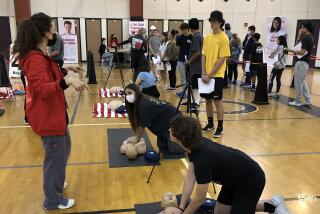Implant Helps Spinal-Cord-Injury Victims Breathe and Talk
- Share via
CLEVELAND — A new device that was surgically implanted into a spinal-cord-injury victim allows him to talk easier and breathe without a bulky ventilator.
“It’s wonderful. There’s nothing like this in the world,” said Tom Conlan, 36, who injured his spinal cord in a swimming accident in 1998 and is a quadriplegic. “When I was on the vent, I’d have to wait for it to give me a breath before I could talk. Now I don’t.”
Doctors at University Hospitals and Case Western Reserve University developed the device, which they described as being less risky and less expensive than previous surgical implants.
About 10,000 Americans suffer spinal cord injuries every year, according to the National Institutes of Health. Of that number, about 500 people suffer injuries that require them to use a ventilator, said Dr. Raymond Onders, who performed surgery on Conlan last year.
Doctors surgically implanted the device in Conlan in an outpatient procedure by placing electrodes on his diaphragm muscle. The electrodes, attached to a small battery pack, stimulate the muscle and the nerve that cause normal inhalation and exhalation.
Conlan said he also has regained his sense of smell and taste.
Kent Waldrep, who heads the Dallas-based Kent Waldrep National Paralysis Foundation, which raises funds to support research on spinal-cord injuries, views the device as a breakthrough.
“Boy, this will be a big improvement in the quality of life for thousands of ventilator-dependent people,” said Waldrep, who became a quadriplegic after being injured while playing football for Texas Christian University in 1974. “For probably the last six years, teams from around the world have been looking at several different devices. I’m glad to see one of them finally succeeded.”
The cost of implanting the new device is less than $10,000, much less than the estimated $100,000 it costs for previous procedures, Onders said. He said the surgery is safer than past procedures, in which doctors would have to open up the patient’s chest.
Onders said he needs to perform more procedures to demonstrate the effectiveness of the device. The goal is to test at least five more patients before seeking FDA approval.
The procedure is funded by University Hospitals, the Veterans Administration, U.S. Surgical Corp. and a three-year, $300,000 grant from the U.S. Food and Drug Administration.






